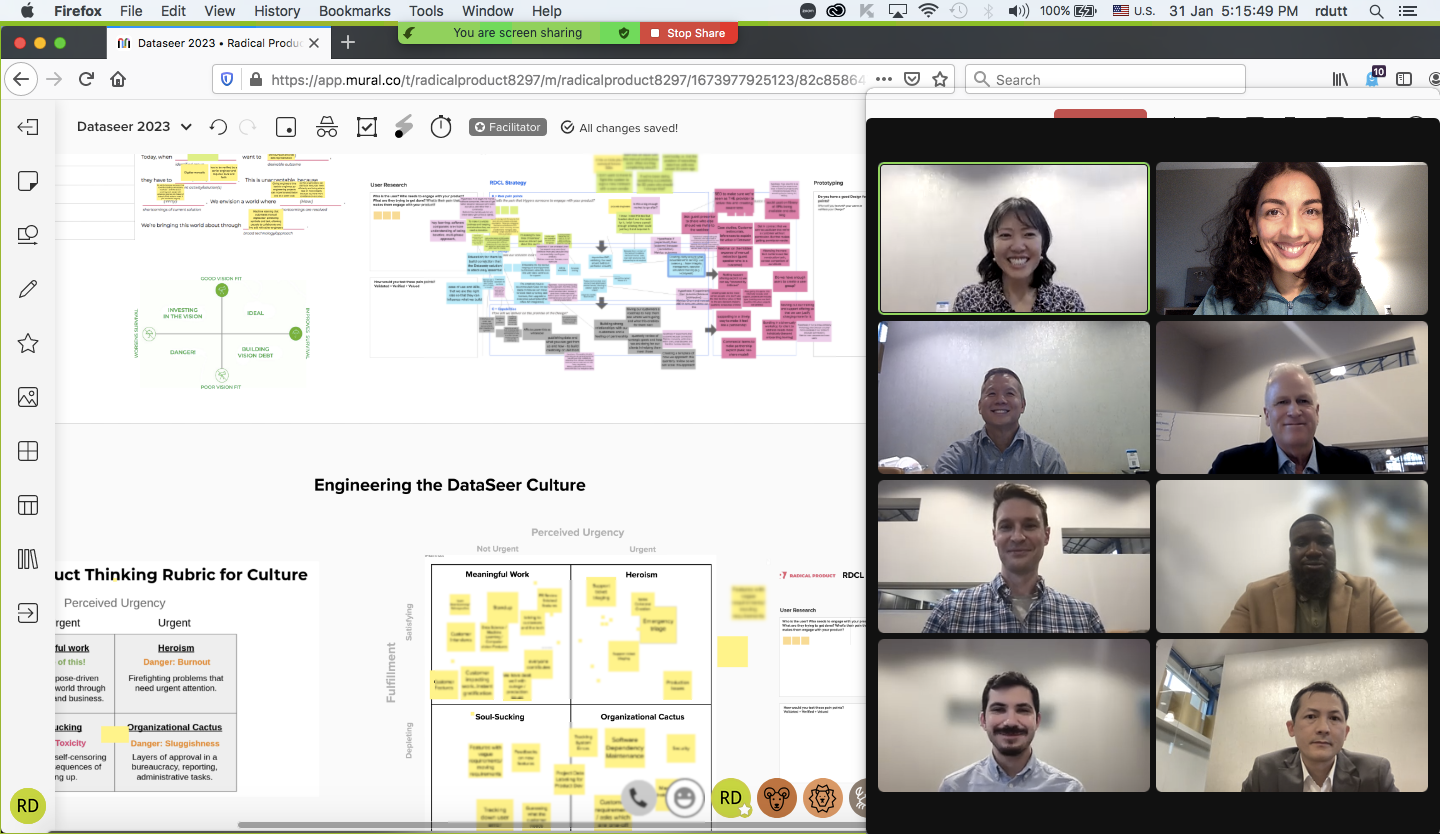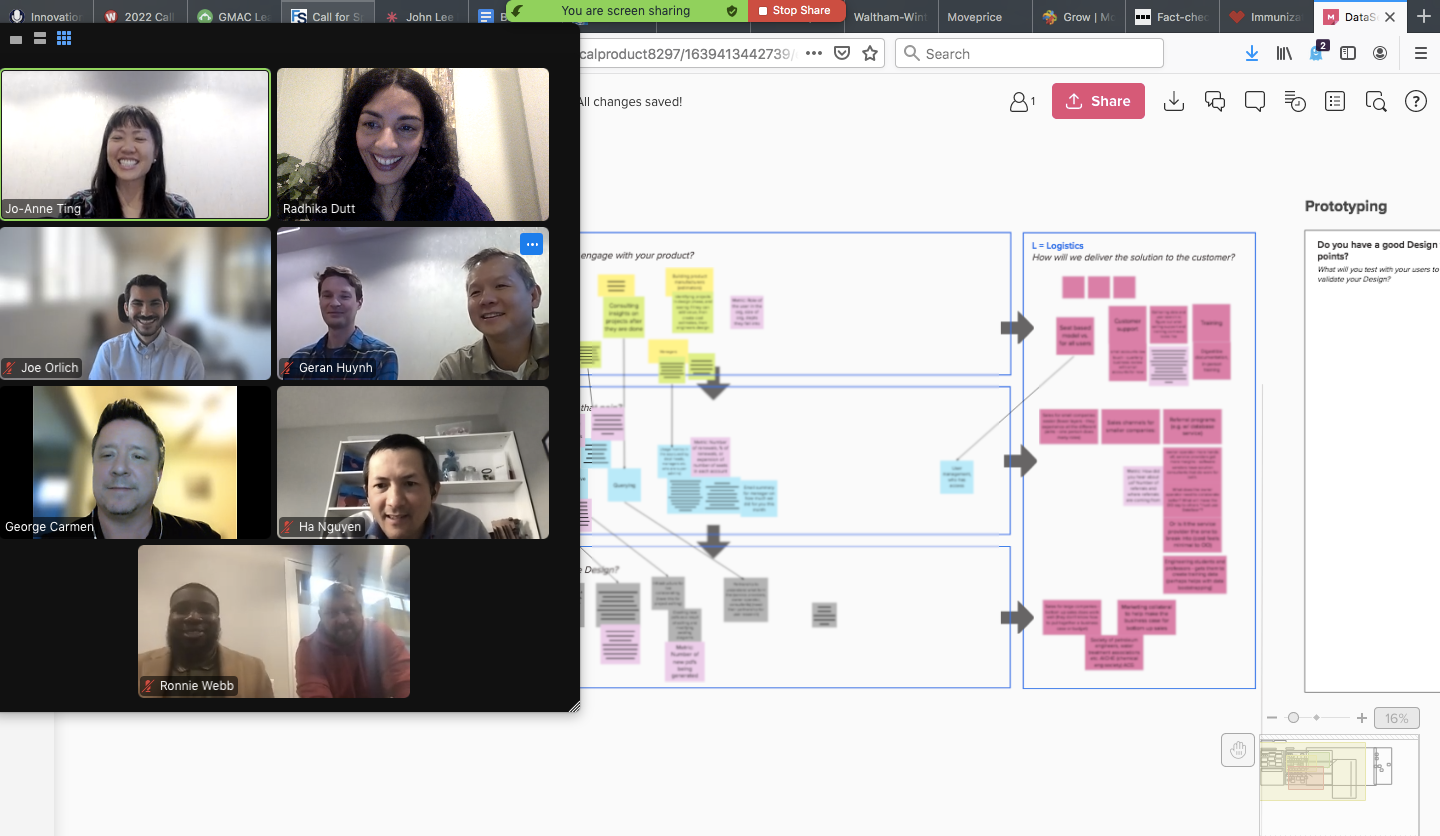If you’re a leader who is managing a pivot and want to align your team in a new direction, or if you have a team that’s new and you want them to gel, this case study gives you the example of how a company, DataSeer, used Radical Product Thinking to manage this successfully.
Background
DataSeer is an AI company that provides automated visualization software to digitize unstructured data trapped in 2D images and creates a digital twin database with API access. In 2021 when the board appointed Jo-Anne Ting as the CEO, the company had just pivoted and most of the team members were new to the company. The team was also completely remote and most people hadn’t met each other in person.
Ting wanted to bring the team together for an offsite to kick off 2022 and align on the problem they were setting out to solve together, and create an actionable plan for the year. So she asked me to facilitate a day-long Racial Product Thinking workshop. She also wanted the kickoff to be a bonding experience for the team and reinforce a culture of collaboration. To achieve the above, we planned an agenda with a set of group exercises to craft a vision, strategy, and derive hypotheses and metrics to measure success.
Vision workshop
The morning agenda included icebreakers and a group visioning session. The RPT approach to a vision statement challenges conventional thinking – it’s not a broad and unchanging statement. Instead it’s a Mad Libs statement that details the answers to the who, what, why, when, and how questions:
- Who: Whose world are we setting out to change?
- What: What is their problem today and how are they solving it?
- Why: Why is the status quo unacceptable?
- When: When can we say “mission accomplished”?
- How: How will we bring about this world?
Team members across different functions including engineering, sales, and customer support, shared diverse perspectives that were thought-provoking as the team considered what problem they were setting out to solve. Their answers also helped air out misalignments so the team could consider these different perspectives and then agree on a shared vision. Most importantly, as each team member contributed to a shared vision, it also helped everyone internalize the vision and make it their own.
Using RPT’s fill-in-the-blanks approach we crafted a Radical Vision Statement for DataSeer that describes the problem statement, why the status quo is unacceptable, and the world envisioned by the team:
Today when [junior engineers], want to [modify a design or build a data model for a simulation with an accurate data representation], they have to [digitize manually by painfully interpreting each symbol and text and the result has to be verified by a senior engineer which requires some back and forth]. This is unacceptable because [it’s soul-crushingly tedious work that people with advanced degrees have to do instead of spending time on solving interesting engineering problems – it’s easy to burnout or feel disengaged when work feels less meaningful]. We envision a world where [engineers get time back so engineering projects can move forward faster and at a lower cost and organizations can take on more projects because they have more confidence in accurate digitization]. We are bringing this world about through [machine learning that automates manual digitization by predicting symbols and text].
Without the RPT approach, I’ve often heard complaints about visioning exercises that feel like an unending game of vision bingo. Instead, a facilitated visioning session for DataSeer to craft this detailed vision took only an hour and a half and was so productive that a team member enthusiastically remarked, “We should have done this exercise when we first started the company!”
Strategy workshop including Hypotheses, and Metrics
Armed with a clear vision, the agenda for the afternoon was to develop a strategy, hypotheses, and metrics to measure success. In the RPT way, we crafted a comprehensive RDCL Strategy to translate the vision into a set of actionable steps. We started by identifying the personas who would interact with the product. Next we identified each of the elements of the mnemonic RDCL, i.e. the Real pain points that each of the personas face, the Design or functionality that would solve those pain points, the underlying Capabilities needed, and finally the Logistics including which sales channels would reach the target customers, and how the company would train and support users.
Once we had crafted a detailed strategy, we could derive metrics to measure progress on the strategy. To take this hypothesis-driven approach, the team identified key elements of the strategy that needed to be tested. We then wrote hypotheses for each of those elements, treating each as an experiment the team would run. Finally, we identified the metrics that would validate each hypothesis and indicate whether that element of strategy is working.
Identifying a clear strategy, followed by deriving hypotheses and metrics from the strategy helped align the team on an actionable plan and how the team would measure success.

Results
The success of the workshops has led to a shift in how DataSeer approaches their yearly kickoff and strategic planning. They now view the vision and strategy workshops as an essential part of the process and a way to keep the team aligned and reinforce the company’s culture of continuous learning and hypothesis-driven execution.
Continuous learning
Hypothesis-driven product development
Lower attrition
The workshop was also an opportunity for the fully remote team to get to know each other better. We had scheduled time for casual conversations and icebreakers, which helped to break down barriers and facilitate bonding between team members. It helped people from each function see things from different perspectives. For example, it helped engineers see the sales and marketing perspective on the problem statement, and it helped to have sales folks asking about product and engineering deployment. It was an opportunity for people to cross outside the functional boundaries of their jobs, be curious, and ask even the simplest questions.”
I was thrilled that the vision and strategy workshops at DataSeer’s offsite supported Jo-Anne in her immensely insightful and thoughtful leadership.
 Vision and Strategy Workshop with the DataSeer team in 2023
Vision and Strategy Workshop with the DataSeer team in 2023
Want to learn more about vision and strategy workshops and how you can transform your organization to be more vision-driven? You can check out the RPT Innovation Workshop and contact us to see how the workshops can be customized for you. You can also read the Radical Product Thinking book, or get the free toolkit.
FAQs
When do you need a visioning session or strategy workshop?
Here are 6 examples of scenarios when a visioning session or a strategy workshop is particularly useful:
- If you’re planning an offsite, instead of communicating direction using a slide deck, consider setting aside some time for a team visioning session and/or a strategy workshop – the latter is infinitely more effective in getting buy-in from the team
- If you have a new team, or if you need to align your team because the product or market has changed significantly
- If you’re building a new product – this is a great way to kick-off
- If you’re working on strategic planning for the year
- If you need to rethink your product or you see the need to pivot
- If you’re seeing product diseases and need a reset to recover from these diseases and become more vision-driven
Do I need a facilitator for a visioning exercise?
Yes, someone needs to be the facilitator for a team visioning exercise to make sure that all voices in the room are heard. You could play this role for your team, but here are the benefits to having an external facilitator for your visioning workshop:
- An external facilitator with experience can ask the right questions to air out misalignments and manage the discussion so the team achieves clarity within the time allotted for the exercise.
- It’s important to not settle for a fluffy vision that sounds good. An experienced facilitator ensures an actionable outcome by getting your team to align on the who, what, why, when, and how for your product/ company.
- Especially in a more hierarchical organization, having an external facilitator helps you avoid the problem of the HIPPO (HIghest Paid Person’s Opinion) swaying the conversation.
- Conventional wisdom that a good vision is a short slogan that is broad, aspirational, and unchanging. An external facilitator makes it easier to challenge conventional wisdom and align the team on the need for a detailed vision before beginning the exercise.
How long does a group visioning exercise take? How much time do I need to set aside for a strategy workshop?
Visioning sessions I’ve facilitated typically just take 1.5 hours – this amount of time is enough to create a Radical Vision Statement that aligns the team on the problem you’re setting out to solve, why the status quo is unacceptable, and the world you envision when you’ve solved the problem. To plan for ice-breakers and a round of sharing key takeaways, you should plan another 30 minutes. A facilitated strategy workshop to craft a RDCL Strategy takes 3 hours.
If we already have a vision statement, is a group visioning exercise still useful?
Most vision statements are broad and fluffy. So your team will find that a group exercise to write a Radical Vision Statement is valuable because it offers clarity on the who, what, why, when, and how questions, i.e. whose problem are you setting out to solve, what is their problem and how are they solving it today, why is the status quo unacceptable, when will you know you’ve arrived, and how will you bring about this world. If your current vision statement already answers these questions, you don’t need a visioning exercise.
